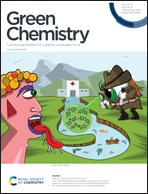Defective ZrO2−x supported Ru nanoparticles as a Mott–Schottky photocatalyst for efficient ammonia synthesis under ambient conditions†
Abstract
Well-crafted semiconductors exhibiting favorable band structures and strong electron-donating properties can provide a viable pathway for solar-driven nitrogen activation under ambient conditions. In this study, we demonstrate that the nitrogen photo-fixation process can be enhanced by introducing oxygen vacancies and a Ru co-catalyst. The Ru-loaded ZrO2−x photocatalyst achieved an impressive NH3 production rate of 3256 μg g−1 h−1 under visible light irradiation (at 400 nm). Defective ZrO2−x with its enhanced reducing ability and narrow band gap possesses a low work function and excellent electron-donating capability, resulting in remarkable photocatalytic performance for ammonia synthesis under visible light. The supported Ru co-catalyst induces upward band bending in defective ZrO2−x, forming an interfacial Schottky barrier that facilitates the separation of photogenerated charge carriers and provides energetic electrons for nitrogen activation. Mott–Schottky photocatalysts with enhanced back donation ability establish a one-way channel for the transmission of photoexcited electrons, thereby further improving the photocatalytic performance of ammonia synthesis at room temperature.



 Please wait while we load your content...
Please wait while we load your content...